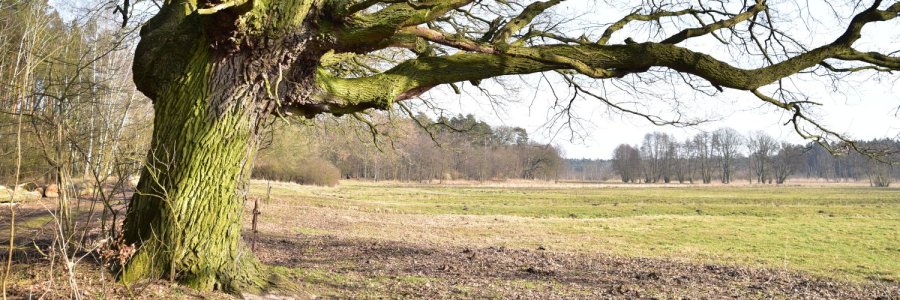An oak hike in the Fürstenberger Werder
In northern Brandenburg lies the Fürstenberger Werder a historical landscape which belonged to Mecklenburg from 1348 to 1950 (WIKIPEDIA 2019). A beautiful and densely wooded landscape, which invites you to hikes and bike tours, and in which many strong old English oak trees (Quercus robur) can be found. On a cold, sunny day in February I set off early in the morning by train from Berlin to Fürstenberg/Havel. From there some busses drive on weekdays over the villages towards Zehdenick and make it possible to get off and on again on the way. Perfect conditions for an eventful day
- In Fürstenberg and by bus to Blumenow
- Blumenow and its ancient oaks
- Over the land and through the forest to Neubau
- A gnome at the "bobble hat"
- Tornow and its old oaks
In Fürstenberg and by bus to Blumenow
Between train arrival and bus departure there is still some time left for some interesting trees in Fürstenberg itself and importantly for a visit of the Bakery Eckert at the B96 north of the small spa park, respectively "Unter den Linden", where unfortunately only one big lime tree is left. A beautiful classic bakery with individual bread and cake offers as provision for the following 18 km hike without further shopping facilities.
Interesting trees are waiting for us:
In the spa gardens the old alders (Alnus glutinosa) with a circumference of up to 3 m, the two plane trees (Platanus x hispanica) in front of the former, unfortunately now closed forest museum, as well as the castle grounds in Fürstenberg have unfortunately been closed off for years. In the small former park around the castle there are still some interesting oak trees (unfortunately not accessible at the moment) and last but not least the oak trees at the Soviet memorial (where the bus also leaves).
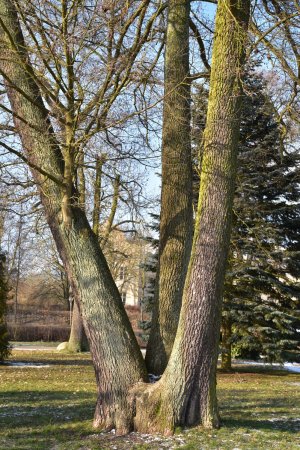
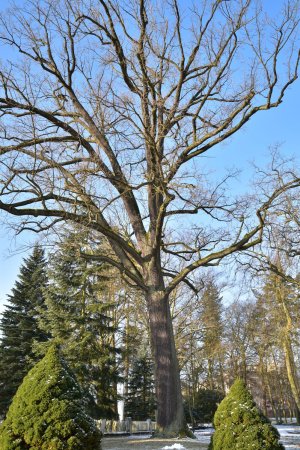
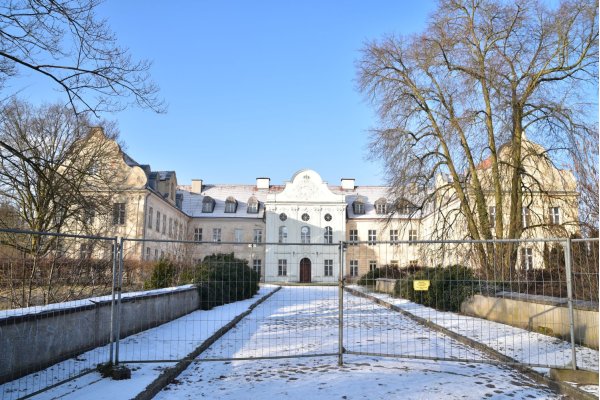
The bus takes us out of Fürstenberg and up through the woods south of the Stolpsee, through the village Zootzen with its Big Lime Tree, unfortunately offside in the village street and only visible from the bus from a distance.
The bus turns a short loop over the Havel and the village square of Bredereiche, my thoughts go briefly to the Swedish oak only 2.5 km north of here at the road to Himmelpfort.
But, full of anticipation, we continue on to Blumenow, the actual destination of the journey and starting point of our hike today.
Blumenow and its old oaks
Blumenow is a small village with an old stone church and an overgrown manor park, although the former manor house unfortunately no longer exists. Directly on the village square at the bus stop stands the first of six remarkable English oaks (Quercus robur) with a broad, high crown over a branchless shaft. The solitary, central location suggests a memorial tree, probably a peace oak from 1871. However, we have no evidence of this.
Similarly, there is another oak tree at the entrance to the churchyard. With a circumference of 4.92 m, it is considerably stronger and its crown is also marked by age and "care measures". At the base of the trunk there is a large memorial stone whose inscription unfortunately no longer exists. But because of its circumference we can classify it quite surely as Peace Oak from 1814.
Such commemorative trees were planted in almost every village in Brandenburg, mostly oaks, for example after the war of liberation 1813/14 in the context of the Napoleonic wars for "liberation" from French or Napoleonic occupation, or after the German-French war 1870/71, but also in 1648 or 1918. These oaks are both cultural and natural monuments and always worth preserving.
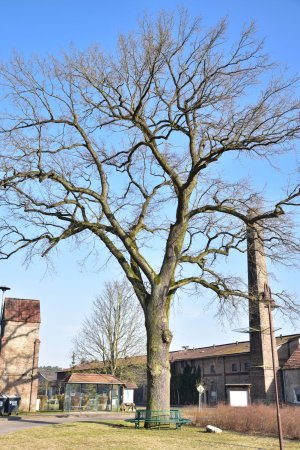
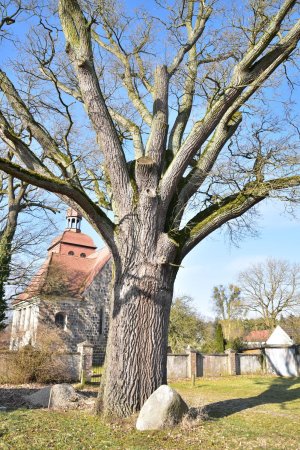
Passing the church and the heritage funeral, you go straight across the churchyard to the Candela oak. But oh dear, what the crown, which seemed to be already missing behind the church from the distance, made me fear, is a sad reality. The oak tree (circumference 6.10 m) with its three prominent, steep and low set crown trunks, which we last visited and measured in 2014, has disappeared, only the ivy-covered stump remained. Back at the village street I meet a resident who remembers that the oak tree broke apart in a storm in 2016/2017, which fits to my notes, in which I had last noted "damage to the trunk base". Hier our last photo of this oak form the year 2014
A detour to the northern edge of the village leads me next to the lightning oak. I had given here its name, because the neighbour of the oak had told me earlier that it was hit by lightning some years ago and looks worse every year since then, a farewell in rates. Even in a leafless condition you can see that it is no longer doing well, numerous are the dry branches and branch breakouts. When measuring the circumference, my gaze also went anxiously upwards.
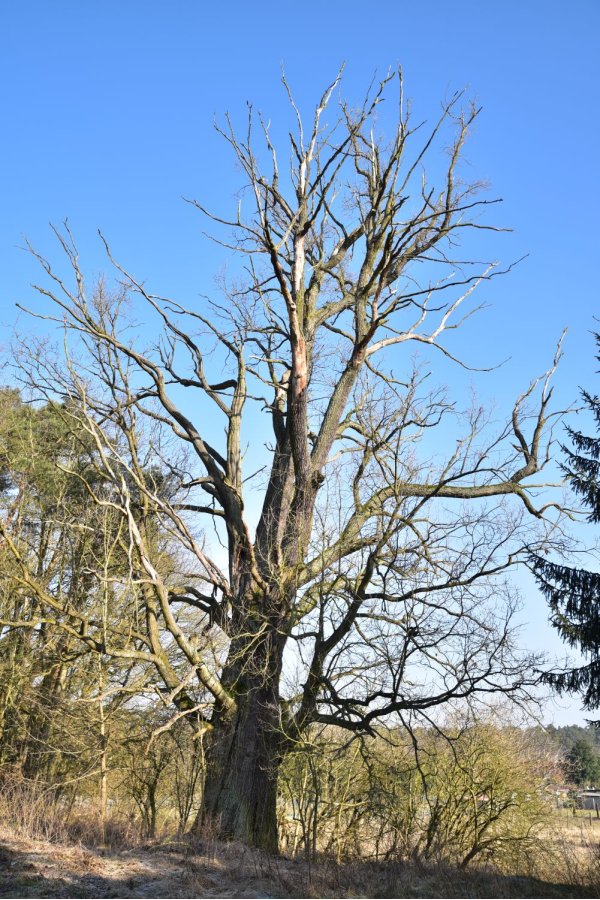
The other remarkable oaks are located south and east of the village, so from here you have to cross the village again, passing the village green and the church. But today I save myself the way to the left over a meadow to the oak in the field wood. A splendid vital tree with a dense, vital crown over a cylindrical, continuous trunk. Actually it looks much stronger and older than the tape measure finally indicates (5.77 m). My secret favourite of all the oaks in and around Blumenow and a real future tree.
Here is a link to the oak tree from a bike tour in April of the same year
On the right-hand side, on another meadow is the very strongest oak specimen of the village and with a circumference of 8.61 m even one of the strongest oaks in Brandenburg, the meadow oak. In 2002 we discovered it for the first time on a bicycle tour, at that time still with a dense leafy crown. But it also seems to have a problem. Over the years the northern part of the crown has died off to a large extent. It is possible that this tree consists of two individuals that have grown together over the centuries, the base and shape of the trunk and the structure of the crown suggest this. We will continue to observe how it will develop.
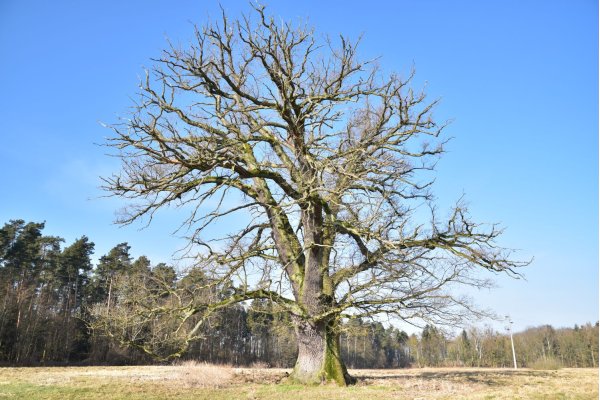
And not far from here, somewhat hidden in the the edge of the forest, further west stands the last oak, it has recently reached six metres in circumference and, despite its height, seems to be growing fast.
Over the land and through the forest to Neubau
But from here finally out of Blumenow, first on the meadow south of the forest to the southwest along the Siebgraben and after 350 m at the forest angle again into the forest. There an old stock with more interesting oaks. But there is not enough time to have a closer look at them all. From here further south along the path alongside the field and back into the forest until it leaves the forest after about 1.5 km at Neubau
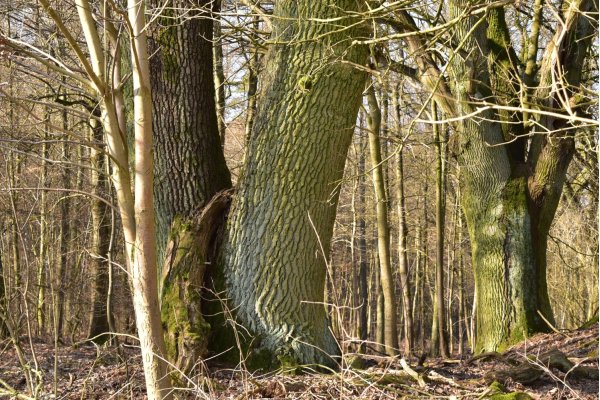
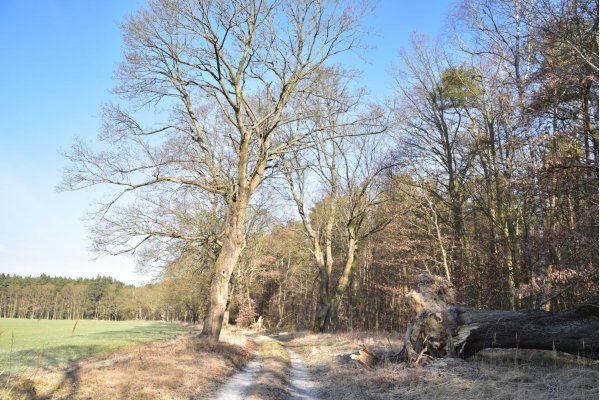
A gnome at the "bobble hat"
The small village Neubau consists of a few buildings and the remains of a large farm, whose large old sheepfold, built of field stones, is today used again by a shepherd. It was only established in the middle of the 19th century and served as a farm for the large beech forest around it. Directly on the path next to the village there is a large oak tree with a deeply tweaked bouquet-shaped crown and a circumference of 6.02 m at breast height (5.79 m at the waist below).
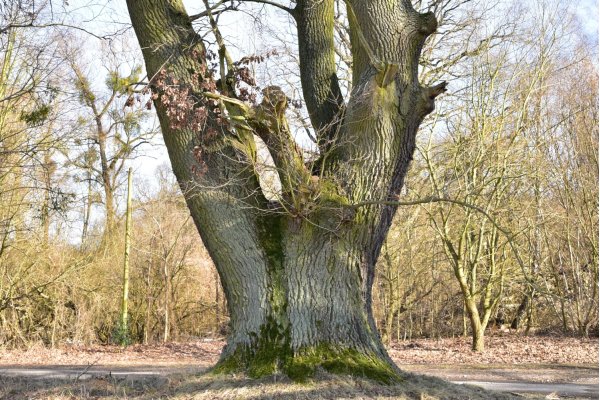
But the real treasure of the place is the so called gnome oak (FRÖHLICH 1994), north of the place at a pond, called poodle cap. Without wanting to anticipate the other oak experiences of today, it is the most beautiful and peculiar oak for today. The trunk is loosing circumference very quickly over its thick base at the base of the trunk. The gnarled, protruding crown branches attach irregularly to the trunk, many branch breakouts. For more pictures and information see here in the East German tree archive, but also here a picture with the this time lonely wanderer.
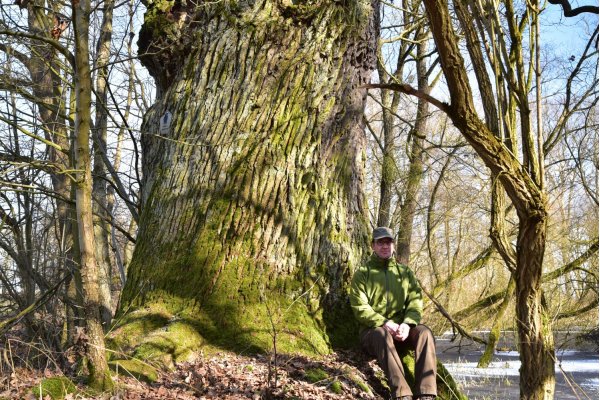
It is definitely worth walking around the pond. The small forest that accompanies it is full of interesting trees, unfortunately some of them have fallen off and broken off in the storms of the past years. Especially noticeable is a hornbeam with an irregular grooved trunk not far from the gnome oak. On the southern shore remarkably several large European beeches (Fagus sylvatica), the strongest with a circumference of over 5 m, a gnarled spirally grown oak with a small crown and large hazel bushes (Corylus avellana).
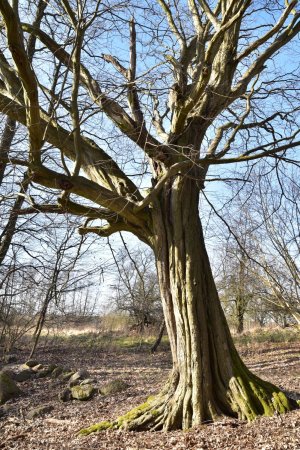
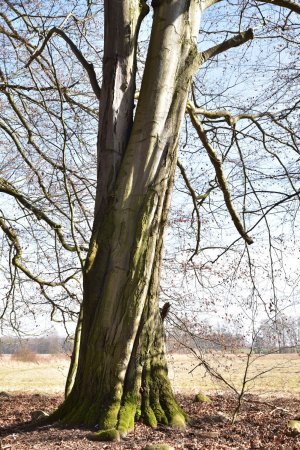
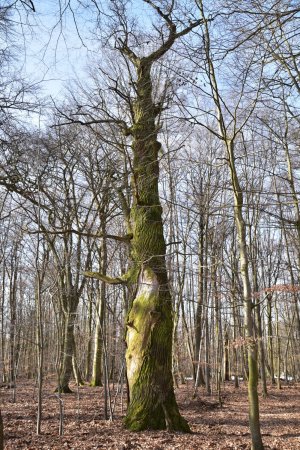
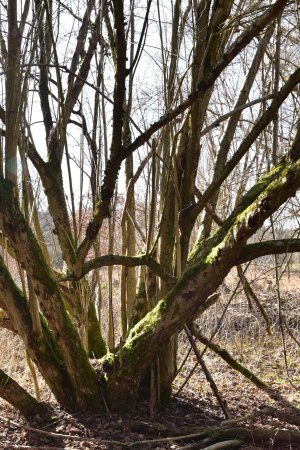
Tornow and its old oaks
to be continued soon....
All photos and texts on this site are, unless otherwise expressly noted, protected by copyright. Each publication requires the permission of the author/photographer.
